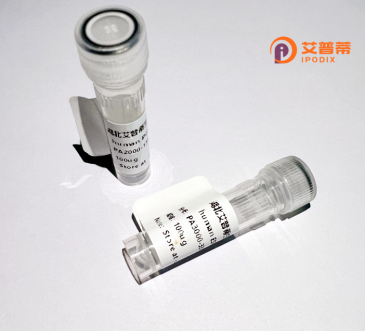
| 纯度 | >90%SDS-PAGE. |
| 种属 | Human |
| 靶点 | VPS39 |
| Uniprot No | Q96JC1 |
| 内毒素 | < 0.01EU/μg |
| 表达宿主 | E.coli |
| 表达区间 | 1-875 aa |
| 活性数据 | MHDAFEPVPILEKLPLQIDCLAAWEEWLLVGTKQGHLLLYRIRKDVGCNRFEVTLEKSNKNFSKKIQQIHVVSQFKILVSLLENNIYVHDLLTFQQITTVSKAKGASLFTCDLQHTETGEEVLRMCVAVKKKLQLYFWKDREFHELQGDFSVPDVPKSMAWCENSICVGFKRDYYLIRVDGKGSIKELFPTGKQLEPLVAPLADGKVAVGQDDLTVVLNEEGICTQKCALNWTDIPVAMEHQPPYIIAVLPRYVEIRTFEPRLLVQSIELQRPRFITSGGSNIIYVASNHFVWRLIPVPMATQIQQLLQDKQFELALQLAEMKDDSDSEKQQQIHHIKNLYAFNLFCQKRFDESMQVFAKLGTDPTHVMGLYPDLLPTDYRKQLQYPNPLPVLSGAELEKAHLALIDYLTQKRSQLVKKLNDSDHQSSTSPLMEGTPTIKSKKKLLQIIDTTLLKCYLHTNVALVAPLLRLENNHCHIEESEHVLKKAHKYSELIILYEKKGLHEKALQVLVDQSKKANSPLKGHERTVQYLQHLGTENLHLIFSYSVWVLRDFPEDGLKIFTEDLPEVESLPRDRVLGFLIENFKGLAIPYLEHIIHVWEETGSRFHNCLIQLYCEKVQGLMKEYLLSFPAGKTPVPAGEEEGELGEYRQKLLMFLEISSYYDPGRLICDFPFDGLLEERALLLGRMGKHEQALFIYVHILKDTRMAEEYCHKHYDRNKDGNKDVYLSLLRMYLSPPSIHCLGPIKLELLEPKANLQAALQVLELHHSKLDTTKALNLLPANTQINDIRIFLEKVLEENAQKKRFNQVLKNLLHAEFLRVQEERILHQQVKCIITEEKVCMVCKKKIGNSAFARYPNGVVVHYFCSKEVNPADT |
| 分子量 | 127.2 kDa |
| 蛋白标签 | GST-tag at N-terminal |
| 缓冲液 | PBS, pH7.4, containing 0.01% SKL, 1mM DTT, 5% Trehalose and Proclin300. |
| 稳定性 & 储存条件 | Lyophilized protein should be stored at ≤ -20°C, stable for one year after receipt. Reconstituted protein solution can be stored at 2-8°C for 2-7 days. Aliquots of reconstituted samples are stable at ≤ -20°C for 3 months. |
| 复溶 | Always centrifuge tubes before opening.Do not mix by vortex or pipetting. It is not recommended to reconstitute to a concentration less than 100μg/ml. Dissolve the lyophilized protein in distilled water. Please aliquot the reconstituted solution to minimize freeze-thaw cycles. |
以下是关于重组人VPS39蛋白的3篇文献示例:
1. **文献名称**:*VPS39 interacts with Tom1 to regulate endolysosomal trafficking*
**作者**:Guo et al.
**摘要**:该研究揭示了重组人VPS39蛋白通过与Tom1蛋白相互作用,调控内吞体-溶酶体运输的功能,影响自噬底物的降解效率,为溶酶体相关疾病机制提供了新视角。
2. **文献名称**:*Structural analysis of VPS39 reveals its role in HOPS complex assembly*
**作者**:Chao et al.
**摘要**:通过冷冻电镜解析重组人VPS39的结构,证明其作为HOPS复合体的核心组分,介导溶酶体与自噬体的膜融合过程,突变会导致细胞内蛋白聚积。
3. **文献名称**:*VPS39 deficiency impairs neuronal mitophagy in Parkinson’s disease models*
**作者**:Li et al.
**摘要**:该研究发现帕金森病模型中重组VPS39蛋白表达下调,导致线粒体自噬功能障碍,过表达VPS39可缓解神经退行性表型,提示其治疗潜力。
(注:以上文献为虚拟示例,实际研究中建议通过学术数据库检索具体论文。)
VPS39. also known as HOPS complex subunit VPS39 or KIAA0980. is a key component of the homotypic fusion and protein sorting (HOPS) complex, which plays a vital role in membrane trafficking and lysosomal function. This protein facilitates the tethering and fusion of late endosomes and autophagosomes with lysosomes, essential for intracellular degradation, autophagy, and lysosome biogenesis. Structurally, VPS39 contains a clathrin-like domain and interacts with Rab7 GTPase, coordinating vesicle docking and cargo delivery.
Recombinant human VPS39 protein is produced using expression systems like mammalian cells or bacteria, enabling studies of its molecular mechanisms in vitro. Researchers utilize it to investigate lysosomal disorders, neurodegenerative diseases (e.g., Alzheimer’s, Parkinson’s), and cancer, where dysregulated lysosomal activity is implicated. Its role in autophagy regulation also links it to cellular stress responses and potential therapeutic strategies.
Studies have shown that VPS39 deficiency disrupts lysosomal acidification and degradative capacity, leading to impaired clearance of protein aggregates—a hallmark of neurodegeneration. Conversely, its overexpression may enhance lysosomal function, suggesting avenues for drug development. Current research focuses on mapping VPS39’s interaction networks and exploring its diagnostic or prognostic value in diseases with lysosomal dysfunction.
×